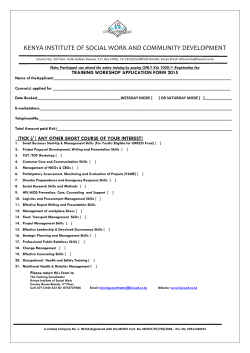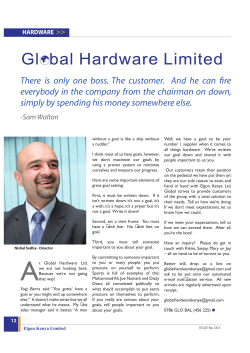
Powerpoint
Systematic Monitoring of the Voluntary Medical Male Circumcision Scale-up in Eastern and Southern Africa: Surgical Efficiencies and Provider Attitudes & Experiences Webster Mavhu on behalf of the SYMMACS team AIDS 2014 – Stepping Up The Pace Background • 14 African countries scaling up Voluntary Medical Male Circumcision (VMMC) • The Systematic Monitoring of the VMMC Scale-up (SYMMACS) assessed scale-up in: – Kenya – South Africa – Tanzania – Zimbabwe Models for Optimizing the Volume and Efficiency of MC Services (2010) Practitioners identified six elements of surgical efficiency that SYMMACS monitored: 1. “Task-shifting” 2. “Task-sharing” 3. Pre-bundling of surgical supplies with disposable instruments (MC kits) 4. Rotation among multiple bays in operating theatre 5. Use of electrocautery/diathermy for hemostasis 6. Use of forceps-guided surgical method SYMMACS Methodology • Process evaluation conducted in 4 countries – Kenya, South Africa, Tanzania & Zimbabwe • 2 serial cross-sectional samples of VMMC sites – Data collected in 2011 and 2012 using same instruments • Included fixed, outreach and mobile sites – Kenya: only country that had mobile sites RESULTS: Summary of Adoption of the 6 Efficiency Elements 2011-2012 Kenya 2011-2012 South Africa Tanzania Zimbabwe 2011-2012 2011-2012 2011-2012 Multiple bays in operating theatre X/X X/X X/X Purchase of pre-bundled kits with disposable instruments X/X X/X Task-shifting X/X Task-sharing X/X X/X X/X X/X Surgical method: forceps-guided X/X X/X X/X X/X Electrocautery to stop bleeding X/X X/X (x)* / X RESULTS • Task-sharing & electrocautery associated with: – Reduced provider time with a client – Reduced operating time • Quality of surgical technique not significantly related to time spent with client or operating time (except in S.Africa in 2012) • Factors related to operating time varied by country and year, but task-sharing reduced operating time in S.Africa & Zimbabwe, and so did electrocautery Regressions by Year & by Country, to Predict Primary Provider Time with Client (PPTC) in Seconds South Africa Coefficien t Tanzania CI Coefficient Zimbabwe CI Coefficient CI Data for sites in 2011 Type of hemostasis - Ligating sutures t -- t -- 178.40** (92.65, 264.15) 257.16** (-362.19, 152.13) -347.84** (-466.23, 227.44) (-235.53**) (-312.67, -158.43) Task-sharing: who performed suturing Primary & secondary Data for sites in 2012 Type of hemostasis - Ligating sutures t -- t -- 166.59** (100.33, 232.85) Primary & secondary t -- -264.02** (-468.15, 59.89) -184.51** (-249.43, -119.6) Task-sharing: non-physician t -- -146.00** (-315.18, 23.18) t -- -48.60** (-61.67, 35.53) 65.42** (17.94, 112.90) -16.75 (-51.33, 17.82) Task-sharing: who performed suturing Mean number of beds RESULTS: • High concordance between each country’s policies and provider attitudes toward the efficiency elements • However, providers expressed frustration over lack of provision for the conduct of certain practices (e.g., task-shifting in S.Africa & Zimbabwe) RESULTS: Work Experience, Job Fulfillment & Burnout among VMMC Providers – Perry et al. (2014) • Providers in all countries reported high levels of personal job-fulfillment • However, many providers reported work fatigue & burnout among themselves and their colleagues • Burnout was highest in Kenya (country with longest running VMMC program) Provider Burnout and Job Satisfaction Kenya South Africa Tanzania Zimbabwe 2011 n=85 2012 n=82 2011 n=105 2012 n=209 2011 n=93 2012 n=206 2011 n= 74 2012 n=94 Performing (or assisting in performing) VMMC is a personally fulfilling job 87.1 84.0 82.9 79.9 100 99.0 81.1 77.7 I personally have begun to experience work fatigue or burnout from performing (or assisting in performing) VMMC repeatedly 70.6 69.5 36.2 32.5 53.8 14.6 27.0 17.0 % who agree or strongly agree that: Recommendations • No amount of surgical efficiency can compensate for weak demand for VMMC services (Rech et al. 2014a) • Countries should consider how best to support & motivate its providers to maintain job-fulfillment and reduce burnout (Perry et al. 2014) • Countries should consult providers & ensure greater understanding of policies to ensure compliance with efficiency elements (Mavhu et al. 2014) Acknowledgment to Country Teams Kenya South Africa Tanzania Zimbabwe Implementing Agency FHI360/Kenya CHAPS MCHIP Jhpiego/Tanzania PSI/Zimbabwe, with ZAPPUZ as subcontractor Co-investigator Dr. Nicholas Muraguri, Dr. Peter Cherutich, Dr. Kawango Agot, Dr. Walter Obiero, Dr. Jackson Kioko Dr. Dirk Taljaard, Dr. James McIntyre Dr. Bennet Fimbo, Dr. Eleuter Samky Dr. Karin Hatzold, Christopher Samkange Country Coordinator Dr. Mores Loolpapit, Mathews Onyango Sasha Frade Michael D. Machaku Webster Mavhu Clinician (data collection) Omondi Dickens, Social Scientist for data collection Rosemary Owigar, Dr. Violet n/a Naanyu n/a n/a Data Manager Omondi Dickens Alexandra Spyrelis Flora Hezwa, Dr. Obadia Venance Nyongole Dudzai Mureyi USAID Mission Anne Murphy Wendy Benzerga, Rebecca Fertziger Duncan Onditi, Seth Greenberg, Eric Mlanga William Jansen Technical assistance and/or sampling Dr. Kate McIntyre, Zebedee Mwandi Carlos Toledo, Lisa Mulwenga Koku Kasaura n/a Manuscript review n/a n/a Hally Mahler Dr Karin Hatzold Nicolas Pule Mulashi Biola, Daniel Dr. Sifuni Koshuma, Shabangu, Sindiswe Zwane, Milton Kabiligi Sindiswe Maseko Dr. Tendai Mutwirah Dr. Eric Nyazika Dr. Kelvin Nemayire Acknowledgement - Other Collaborators Principal investigators Jane T. Bertrand (PI), Dino Rech (co-PI) Co-investigators Emmanuel Njeuhmeli, Delivette Castor, Jason Reed Technical Advisory Group to the R2P Project for VMMC (convened in 2010) Bertran Auvert, Stella Babalola, Robert Bailey, Kelly Curran, Kim Eva Dickson, Timothy Farley, Ron Gray, Jason Reed, Caroline Ryan; also present from USAID: Benny Kottiri, David Stanton, Alison Cheng, Timothy Mah, Emmanuel Njeuhmeli. USAID/Washington: Emmanuel Njeuhmeli, Delivette Castor, Alison Cheng, Benny Kottiri, Sarah Sandison, Timothy Mah PEPFAR/CDC/Atlanta: Jason Reed (at the time of initiation of the study) Center for Communication Programs (CCP), Johns Hopkins Bloomberg School of Public Health: Susan Krenn, William Glass, and Mark Beisser; and from R2P staff (CCP): Deanna Kerrigan, Caitlin Kennedy, Brandon Howard, Emily Hurley, Heena Brahmbhatt, Andrea Vazzano, ‘Kuor Kumoji, Erica Layer, Jessica Spielman and Margie Wild Technical and administrative support / Tulane SPTHM Alan Czaplicki, Bobbie Garner-Coffie, Frances Mather, Christopher Swalm. Research support / Tulane SPTHM Linnea Perry, Margaret Farrell, Nicholas Thomas The USAID | Project SEARCH, Task Order No.2, is funded by the U.S. Agency for International Development under Contract No. GHH-I-00-07-00032-00, beginning September 30, 2008, and supported by the President’s Emergency Plan for AIDS Relief. The Research to Prevention (R2P) Project is led by the Johns Hopkins Center for Global Health and managed by the Johns Hopkins Bloomberg School of Public Health Center for Communication Programs (JHUCCP).
© Copyright 2025












